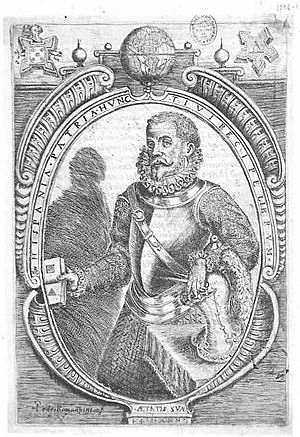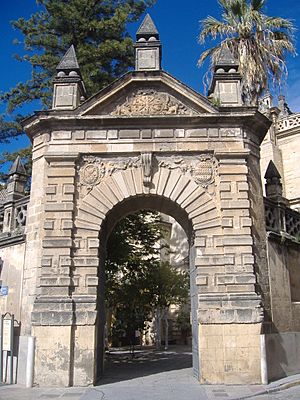Cristóbal de Rojas facts for kids
Quick facts for kids
Cristóbal de Rojas
|
|
|---|---|
 |
|
| Born | 1555 |
| Died | 1614 |
| Nationality | Spanish |
| Occupation | Architect and Military Engineer |
| Known for | Fortifications of Cadiz |

Cristóbal de Rojas (born in Baeza in 1555 – died in Cadiz in 1614) was a skilled Spanish military engineer and architect. He is famous for his work on building strong defenses for cities. He also helped design important buildings. One of his early jobs was assisting Juan de Herrera with the huge El Escorial monastery.
Contents
Who Was Cristóbal de Rojas?
Cristóbal de Rojas was born in Baeza, Spain, in 1555. He grew up to become a very respected architect. By 1586, he was working in Seville. There, he became well-known for his building designs. One of his notable designs in Seville was the Tabernacle Church.
Becoming a Military Engineer
Rojas learned a lot from Tibúrcio Spannocchi, who was the king's engineer. This training made him very interested in military architecture. This is the art of designing and building forts and defenses.
In 1586, he helped check the forts in Gibraltar and Cadiz. After this, he became very busy building forts. He designed and built many defenses in Spanish lands. This included places in North Africa during a time of conflict.
His Important Book on Forts
In 1597, Cristóbal de Rojas finished a very important book. It was called "Theory and Practice of Fortification." This was the first book of its kind published in Spain. It shared new ideas about how to build forts. These ideas were influenced by Italian experts.
Building in Sanlúcar and Cadiz
Rojas also worked on big projects in Sanlúcar de Barrameda. He designed the beautiful carved stone front of the Santo Domingo Church. This work started in 1596 and took ten years to finish.
As a military architect, he had a crucial job in Cadiz. In 1596, the city was attacked and looted by English and Dutch forces. Rojas was chosen to rebuild and strengthen Cadiz. He also rebuilt the old Santa Cruz Church, which was damaged in the attack.
He designed and built Fort San Felipe. This fort was located in La Mamora, a Spanish area in northern Morocco.
Fortifying Cadiz
Rojas's most important work was making the entire city of Cadiz strong. This was one of the biggest military projects in Spain during the reigns of Philip II of Spain and Philip III of Spain. He designed important parts, like the Castle of Santa Catalina, which began in 1598.
Cristóbal de Rojas died in Cadiz in 1614. After his death, another military engineer, Ignacio de Sala, continued the work on Cadiz's defenses.
See also
 In Spanish: Cristóbal de Rojas (arquitecto) para niños
In Spanish: Cristóbal de Rojas (arquitecto) para niños


